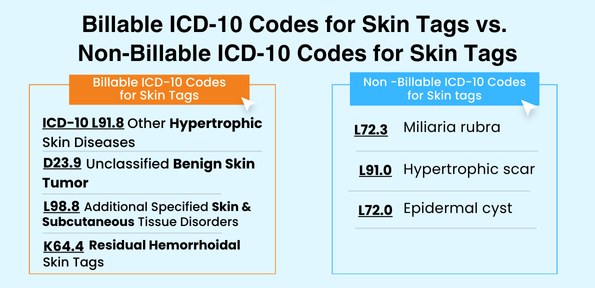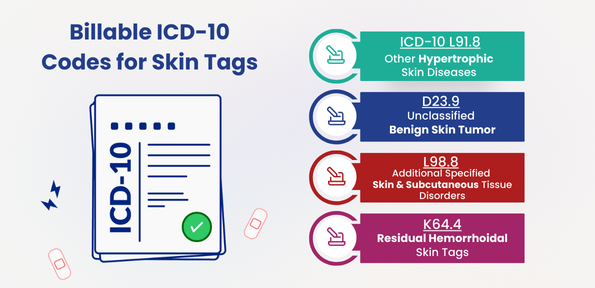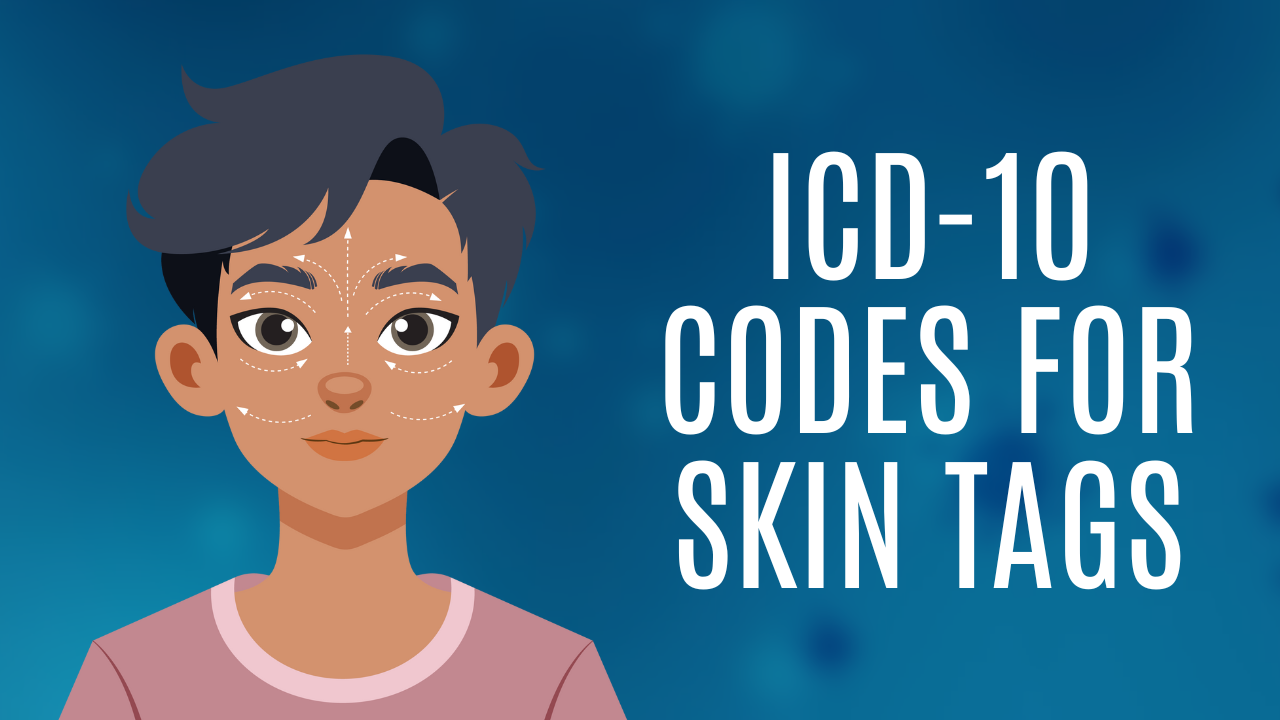ICD-10 Codes for Skin Tags: A Guide for Healthcare Professionals
Skin tags also known as Acrochordons, are small, soft and harmless benign growths, commonly appearing on skin. Although they are harmless, sometimes they can cause irritation or may bleed if they rub against clothing or jewelry. Some people remove these skin tags for cosmetic reasons. If they cause frequent discomfort, removal is necessary.
Find the ICD-10 codes for skin tags, including classifications, billing details, and medical guidelines. Stay updated with accurate coding for proper documentation.
When documenting skin tag removal, using the correct ICD-10 codes for skin tags is essential. Incorrect coding can lead to insurance claim denials or delays in payment. But the most important thing you need to know: insurance companies only allow payment when the skin tag removal process is done medically.
Healthcare providers need to understand ICD-10 codes for skin conditions. It ensures accurate clinical documentation and seamless insurance claim processing. But finding the right code can be challenging.
So, today here in this blog, we are going to explain the ICD-10 codes for skin tags. This includes their classification, location-based codes and billing details.
Let’s read this carefully and know the correct codes to ensure what’s important: better patient care.
What Are ICD-10 Codes for Skin Tags?
ICD-10 Codes for Skin Tags help doctors and other healthcare professionals to record, classify and treat any skin tags accurately and effectively. These also ensure accurate medical documentation and proper billing. As a result, there is no chance for claim denials and payment delays.
Explore more insights Keizer technologies – your go-to resource for accurate medical coding and billing solutions.
How ICD-10 Codes Matter for Skin Tags?
ICD-10 codes like L91.8 and D23.9 help healthcare professionals to accurately identify the skin tags and distinguish them from other skin conditions. These ICD-10 codes for skin tags ensure:
- Accurate clinical records
- Clear documentation of where the skin tag is located
- Clear differentiation from other skin conditions
- Better support for accurate insurance claims
- Easier approval for clinical skin tag removal procedures
ICD-10 codes for skin tags helps in accurate disease diagnosis. Most importantly, it ensures proper insurance reimbursements for required treatments.
Here we talk about the most common ICD-10 codes for skin tags. It also includes easy-to-understand clinical details and clarifies each code. So, choose the right code for the patients and improve the chances of insurance approval. Visit RevMaxx for expert medical coding solutions.
Skin Tag ICD-10 Codes List

BillableICD10CodesforSkinTagsvsNonBillableICD10CodesforSkinTags
| Skin Tag Location/Condition | ICD-10 Code | Reason/Explanation | Billable/Unbillable |
| Neck | L91.8 | Hypertrophic skin disorders can include skin tags in areas like the neck. | Billable |
| Irritated | L91.8 | Irritated skin tags fall under “Other hypertrophic disorders of the skin.” | Billable |
| Inflamed | L98.8 | Inflamed skin tags can be coded under “Other specified disorders of skin.” | Billable |
| Eyelid | D23.9 | Benign neoplasm of skin; covers skin tags in specific locations like the eyelid. | Billable |
| Face | D23.9 | Benign neoplasm of skin, unspecified, applies to facial skin tags. | Billable |
| Left Axilla | L91.8 | Hypertrophic skin disorders, such as skin tags, may occur in the axilla. | Billable |
| Bleeding | L98.8 | Bleeding skin tags are considered “Other specified disorders of the skin.” | Billable |
| Rectal | K64.4 | Residual hemorrhoidal skin tags are often found in the rectal region. | Billable |
| Genital | L98.8 | Genital skin tags fall under “Other specified disorders of the skin.” | Billable |
| Unspecified | D23.9 | Unclassified benign neoplasm of skin, including unspecified skin tags. | Billable |
| Labial | L98.8 | Skin tags on the labia are classified as “Other specified disorders of the skin.” | Billable |
| Groin | L91.8 | Hypertrophic disorders include skin tags in the groin area. | Billable |
| Back | D23.9 | Benign neoplasm of skin; back is included under unspecified locations. | Billable |
| Perianal | K64.4 | Perianal skin tags are classified under residual hemorrhoidal skin tags. | Billable |
| Ear | D23.9 | Benign neoplasm of skin, unspecified, includes locations like the ear. | Billable |
| Anus | K64.4 | Residual hemorrhoidal skin tags commonly occur around the anus. | Billable |
Billable ICD-10 Codes for Skin Tags
If your skin tags cause critical symptoms and need any medical intervention, doctors use specific ICD-10 codes for billing. Some of the valid billable ICD-10 codes for skin tags are:

- L91.8: Other Hypertrophic Skin Disorders
- L98.8: Other Skin and Subcutaneous Tissue Disorders
Healthcare providers use these ICD-10 codes for skin tags with correct CPT code. These help them to get better insurance reimbursement for necessary skin tag removal procedures.
Let’s check some of the billable ICD-10 codes for skin tags:
ICD-10 L91.8 — Other hypertrophic disorders of the skin
This ICD-10 code stands for various hypertrophy skin conditions. It is applicable when there is not a more specific code available for skin tags or other overgrown skin conditions.
Since it is a general code, doctors should use this for a more specific one. However, if no better option exists, this code can be used to document and bill for some skin tag-related cases.
When using this code for skin tags, it is crucial to write accurate clinical notes. This should include the follow:
- A clear description of the skin tags
- Accurate location
- Any related symptoms
D23.9 — Benign neoplasm of skin, unspecified
This is another crucial ICD-10 code for skin tags, used for any non-cancerous skin growth.
Doctors use D23.9 to diagnose any skin tag. While removing the skin tag, they can also use this code for billing both the diagnosis and procedure.
Let’s check how to bill for Skin Tags with D23.9:
- Diagnose the skin tag using this code: D23.9
- Bill for the diagnosis
- If the skin tag needs to be removed, perform the clinical process
- Create billing for removal process
This ICD-10 code is a part of the D22-D23 category for benign skin growths. It helps the insurer to understand that the diagnosis and treatment process involve a harmless skin condition.
L98.8 — Other specified disorders of the skin and subcutaneous tissue
This ICD-10 code for skin tags is used for those skin conditions that do not fit into any specific category. It falls under “Other specified skin and subcutaneous tissue disorders” and helps in proper documentation and billing of skin tag removal.
Apart from skin tags, this code also covers various skin and tissue conditions. So, as a healthcare professional, all you need to ensure proper documentation to correctly use this code.
While using L98.8 code for skin tag removal, doctors also have to include the right CPT code for the specific procedure. Using both these codes together, they can ensure accurate billing and payment for the treatment.
K64.4 — Residual hemorrhoidal skin tags
Residual hemorrhoidal skin tags are loose skin pieces which are left behind after hemorrhoids heal or are treated properly. It is the result of the healing process. But sometimes it can cause irritation or discomfort and may require further removal.
This K64.4 ICD-10 coding is used to document and bill for these skin tag leftovers. It is a billable code and healthcare professionals can use this for billing to diagnose and treat the condition. But remember one thing: this ICD-10 code for skin tags can not be used for treating any active hemorrhoids or other rectal conditions.
While using this code, doctors need to make sure that the clinical records clearly mention the presence of residual hemorrhoidal skin tags.
Non-Billable ICD-10 Codes for Skin Tags
Some ICD-10 codes for Skin tags do not qualify for insurance coverage. Sometimes there is no need for a medical procedure for skin tag removal and this is the place where Non-billable codes are applicable.

Removing skin tags for cosmetic reasons is not considered as medically necessary and it won’t get insurance coverage. So, for cosmetic skin tag removals, patients have to pay for out-of-pocket.
If the doctors use non-billable ICD-10 codes for insurance claims, it is likely to be denied.
Here we are talking about some of the crucial Non-Billable ICD-10 codes for skin tags:
L72.3 — Miliaria Rubra
Miliaria Rubra is a skin condition which may happen due to blocked sweat glands. Due to the trapping sweat under the skin, patients can experience small, red and itchy bumps or blisters. People who are residing in extreme hot and humid weather or sweating a lot, can have this skin tag issue.
In the case of Miliaria Rubra, healthcare providers can use L72.3 ICD-10 code for documenting and billing for treating this heat rash condition. Remember: one can use this code for skin tag treating.
L91.0 — Hypertrophic Scar
Hypertrophic scars are thick, raised scars on skin. This is caused after injury, burn, surgeries or due to skin inflammation. During healing, our body produces too much collagen which makes the scar larger than usual.
This scar may look similar to skin tags, but they are different. Skin tags are small, harmless skin growths, while hypertrophic scars are the normal parts of the body’s healing process.
The L91.0 ICD-10 code is specifically used for Hypertrophic scars, not for the skin tags. This code is non-billable and can not be used for insurance reimbursements.
L72.0 — Epidermal Cyst
This ICD-10 code is used for an Epidermal cyst. Doctors can use this for better documentation. But when treating skin tags, doctors can not use this for billing purposes.
An epidermal cyst is a small lump under the skin filled with keratin. If a doctor checks a skin tag and finds it is actually an epidermal cyst, they may write it down using L72.0 code. This helps them to explain the diagnosis process.
Skin tags are considered as a cosmetic issue, not a medical one. So, this ICD-10 code can not be used for billing. Most importantly, epidermal cyst can appear anywhere on the body and are not similar to Skin tags. So, this L72.0 code can not specifically be used for skin tags.
Key Points about Skin Tags
- Skin tags are small, soft, harmless growths on skin. It can appear on any body part.
- They feel smooth and can be in light brown or darker shade.
- Some of the common areas for skin tags are neck, armpits, eyelids, underarms, groin, anal area, lower torso etc.
- They are harmless unless rubbed by clothes , jewelry or touched too much.
- Skin tags are usually common in mid-age people, older adults and people with overweight issues.
- These are safe and do not spread to others. Skin tags can develop due to hormonal changes specially during pregnancy or diabetes conditions.
- Some people remove this skin tag for cosmetic reasons and some for medical reasons.
- If the skin tag removal is done only for cosmetic purposes, insurance does not cover the claims.
FAQs
- How to code ICD-10 for skin tags?
Choosing the right ICD-10 codes for skin tags is quite challenging for the healthcare professionals. There are too many codes available and most of the skin issues look similar.
Any mistakes can cause errors, leading to claim denials, rejections and lost revenue. So, while choosing the ICD-10 codes, the doctors and healthcare providers need to understand the following:
- Types of skin tags and their codes
- Proper medical documentation needs
- Correct use of coding modifiers
- Following AAPC(American Academy of Professional Coders) Rules and regulations
- Is skin tag a diagnosis?
Yes, skin tag is considered as a diagnosis. Doctors can visually identify skin tags as a benign (harmless) growth on skin. While it is not a serious condition, most people go for skin tag removal for cosmetic reasons. If it causes any kind of pain or irritation, immediate removal or treatment is necessary for medical reasons.
- What are other names for skin tags?
Skin tags are also called as:
- Acrochordons
- Fibroepithelial polyps
- Soft fibromas
- Cutaneous papillomas
- Skin tabs
- Do insurance companies pay for skin tag removal?
If the skin tag removal is done only for cosmetic reasons, the insurance company does not pay for this. However, if these cause pain or any irritation and need medical attention, only then ICD-10 billable codes can be used for diagnosis and treatment. Then the insurance company will cover the treatment.
- What is the ICD-10 code for residual skin tags?
The ICD-10 code for residual skin tags is K64.4.
- What is the ICD-10 code for nevus skin tag?
The ICD-10 code for a nevus skin tag is D23.9. This code refers to “Other benign neoplasm of skin, unspecified”. This also includes most skin tags, including nevus-type skin tags.


